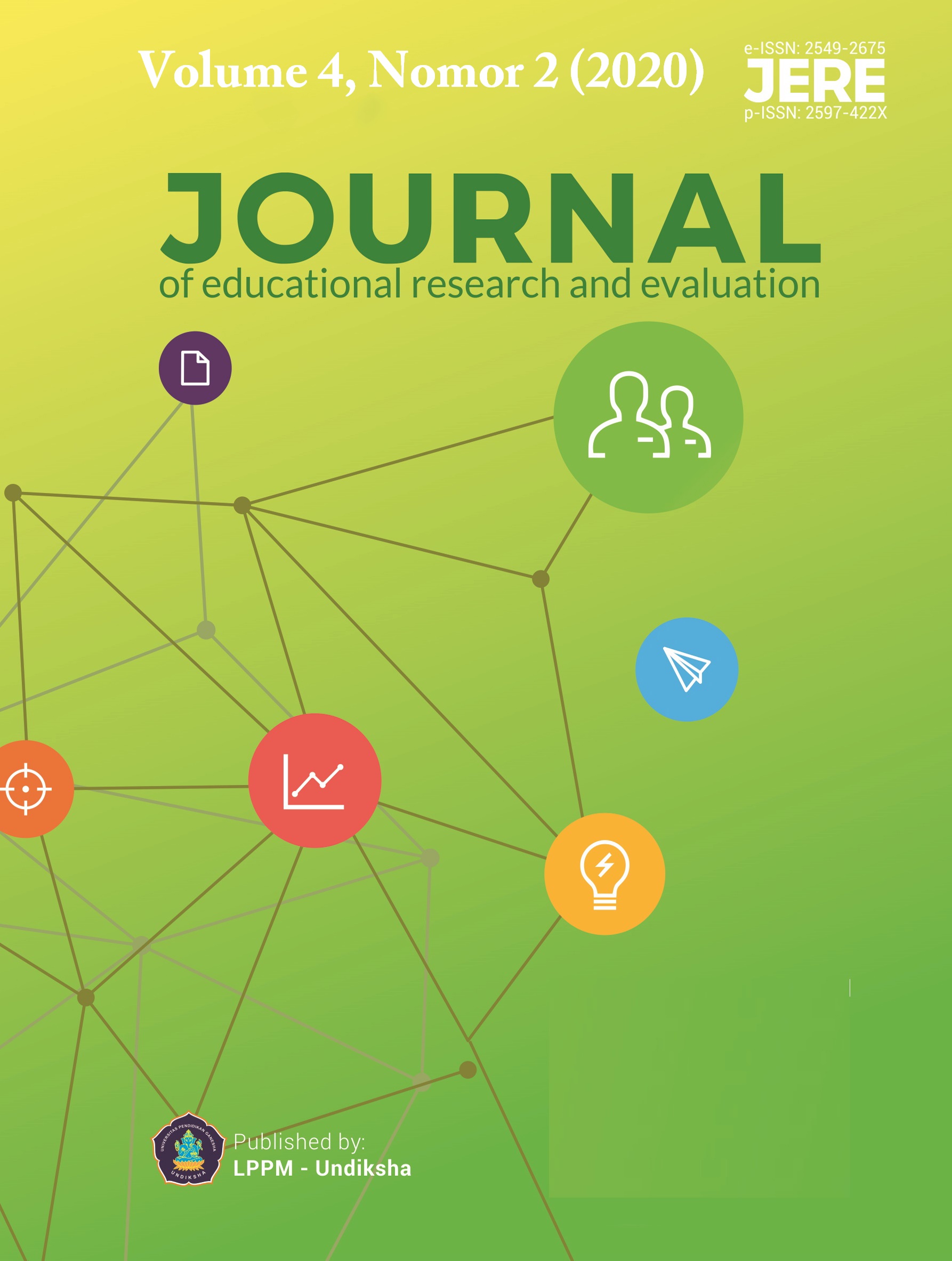Structural Equation Modelling (SEM) on Teacher Competencies Test of Indonesian EFL Senior High School Teachers
DOI:
https://doi.org/10.23887/jere.v4i2.17515Keywords:
Teacher Competencies Test, Education Background, Structural Equation Model, AmosAbstract
The purpose of this paper is to investigate what factors influenced on Teacher competencies Test (Uji Kompetensi Guru/UKG) of Indonesian ESL Senior High School teacher’s in West Java Indonesia. The data used in this study were derived from a teacher competencies test, and a questionnaire survey conducted among teachers who attended National Gathering of Senior High School English Teachers 2017 in Bandung, West Java. A total of 61 usable responses were received. The analysis was using Structural Equation Model (SEM) to see the correlations among variables also identify which predictors influenced most on Teacher Competencies Test. The result revealed that teacher competencies test was mostly influenced by education background (β =.27, p=0.028). It can be concluded that to increase the teacher’s competencies can be done by giving a chance to teachers to continue their study.
References
Aisyah, I., Yuliasri, I., & Warsono, W. (2018). The Professional and Pedagogic Competences of English Teachers With Different UKG (Teaching Competence Test) Achievement Levels. English Education Journal, 9(1), 74-83. https://doi.org/10.15294/eej.v9i1.27643
DeMatthews, D. (2015). Getting Teacher Evaluation Right: What Principals Need to Know. The Educational Forum, 79: 81–89, 2015.
Division of Statistics+Scientific Computation. (2012). Structural Equation Modeling Using AMOS (An Introduction). Austin : The University of Texas.
J.H. Sandholtz, S.P. Scribner. (2006). The paradox of administrative control in fostering teacher professional development. Teaching and Teacher Education, 22 (2006), pp. 1104-1117
Hu L-T, Bentler PM. Cutoff. (1999). criteria for fit indices in covariance structure analysis: conventional criteria versus new alternatives. Struct Equ Model 1999;6: 1–55.
Hox, J.J., Bechger, T.M. (1999). An Introduction to Structural Equation Modelling. Family Science Review, 11, 354-373.
Kline RB. (2005). Principles and Practices of Structural Equation Modeling. 2nd ed. New York, NY: the Guilford Press; p. 105.
Kusumawardhani,P.N. (2017) .Does teacher certification program lead to better quality teachers? Evidence from Indonesia, Education Economic.s, 25:6, 590- 618, DOI: 10.1080/09645292.2017.1329405
L.E. Frase.(2001). Constructive feedback on teaching is missing. Education, 113 (2001), pp. 176-181
Little RJA, Rubin DB. (2002). Statistical Analysis with Missing Data. 2nd ed. New York, NY: Wiley.
MacCallum RC, Browne MW, Sugawara HM. (1996). Power analysis and determination of sample size for covariance structure modeling. Psychol Methods Page:130–149.
Marks, R. (1991). When should teachers learn Pedagogical content knowledge. Paper presented at Reviews the AERA annual meeting, 1991. California
Mustafa, M.N., (2013). Professional Competency Differences among High School Teachers in Indonesia; International Education Studies Journal Vol.6, No.9, E-ISSN 1913-9039. DOI: 10.5539/ies.v6n9p83.
Michel Grangeat & Peter Gray .(2007). Factors influencing teachers' professional competence development, Journal of Vocational Education & Training, 59:4, 485-501, DOI: 10.1080/13636820701650943
OECD. (2005). Teachers Matter: Attracting, Developing and Retaining Effective Teachers, OECD, Paris.
OECD. (2009). Creating Effective Teaching and Learning Environments: First Results from TALIS, OECD, Paris.2009b
Schreiber,James B.(2008). Core reporting practices in structural equation modeling. Science Direct Research in Social and Administrative Pharmacy ,4 (2008) 83–97.
Shullman, L. S. (1990). Knowledge and teaching: Foundations of Reviews the new reform. Harvard educational review, 57(1), 1-22
Undang Undang Republik Indonesia Nomor 14 Tahun 2005 Tentang Guru dan Dosen
Yu C-Y. (2002). Evaluation of model fit indices for latent variable models with categorical and continuous outcomes. MPlus software Web site. Available from: http://www.statmodel.com; 2002. Accessed 05.01.05.
Zulfah, dan Nurjannah. (2016) .Uji Kompetensi Guru. Yogyakarta : Bright Publisher
Widiati,U. and Hayati, Nur . (2015). Teacher Professional Education in Indonesia and ASEAN 2015: Lessons Learned From English Language Teacher Education Programs . Camtesol & Leia:Phnom Pehn.
Downloads
Published
How to Cite
Issue
Section
License
Authors who publish with the Journal of Evaluation and Research in Education (JERE) agree to the following terms:
- Authors retain copyright and grant the journal the right of first publication with the work simultaneously licensed under a Creative Commons Attribution License (CC BY-SA 4.0) that allows others to share the work with an acknowledgment of the work's authorship and initial publication in this journal.
- Authors are able to enter into separate, additional contractual arrangements for the non-exclusive distribution of the journal's published version of the work (e.g., post it to an institutional repository or publish it in a book), with an acknowledgment of its initial publication in this journal.
- Authors are permitted and encouraged to post their work online (e.g., in institutional repositories or on their website) prior to and during the submission process, as it can lead to productive exchanges, as well as earlier and greater citation of published work. (See The Effect of Open Access)











